|
|
Post by Markbo on Nov 26, 2015 10:05:10 GMT -5
For anyone interested there was a write up on LT-32 in Handloader magazine no.293, December 2014
|
|
|
|
Post by Lee Martin on Nov 30, 2015 20:37:10 GMT -5
Cutting Groups - Part VI ______________________________________ Results from last Wednesday – I arrived at the range around 8 AM to find 29 degrees and 55% humidity. Starting with 27.7 grs of LT-32 (touch) the first two groups went 0.234” and 0.209”. This led me to believe I was on my defined node. The higher position hadn’t been tried so I loaded a few 28.3’s. By then it warmed to 42 degrees and 44% humidity. Through calm air the stiff charge printed tighter than 27.7. I assembled more and the next target confirmed the node. These were fired consecutively within 25 minutes of each other. The shape, POI, and spread are nearly identical. This is the type of consistency we aim for in benchrest shooting.  Group #1 @ 28.3 grs: • Time – 9:50 AM • Temp = 42.3, humidity = 44.6% • 28.3 grs of LT-32, Lot #6 (51.5 Culver measure) • Velocity – TBD • 68 grain FB Bart’s Ultra • Seating – touch (#35 Sinclair seater) • Brass – Lapua, 10th firing • 0.0015” neck tension – 0.261” bushing • CCI BR-4 primer • Shoulder bump = 0.001” • Loaded neck = 0.2625” on a 0.264” chamber. 0.0015” clearance Spread = 0.424” – 0.243” = 0.181” 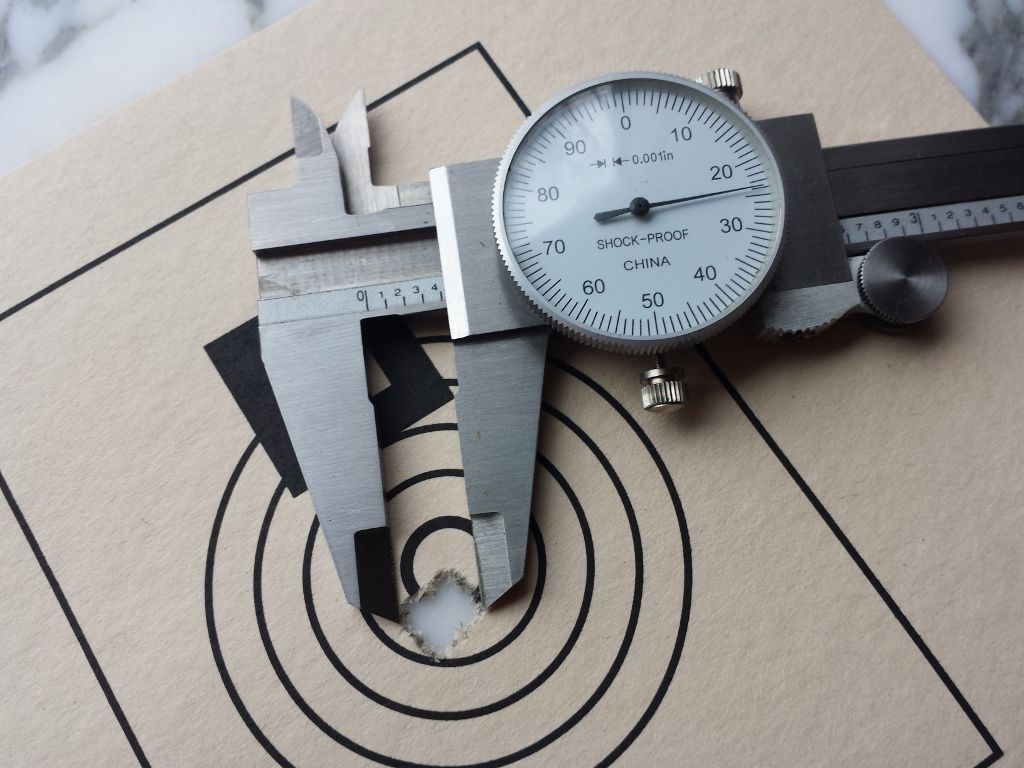 Group #2 @ 28.3 grs: • Time – 10:12 AM • Temp = 42.9, humidity = 44.1% • 28.3 grs of LT-32, Lot #6 (51.5 Culver measure) • Velocity – TBD • 68 grain FB Bart’s Ultra • Seating – touch (#35 Sinclair seater) • Brass – Lapua, 10th firing • 0.0015” neck tension – 0.261” bushing • CCI BR-4 primer • Shoulder bump = 0.001” • Loaded neck = 0.2625” on a 0.264” chamber. 0.0015” clearance Spread = 0.424” – 0.243” = 0.181” 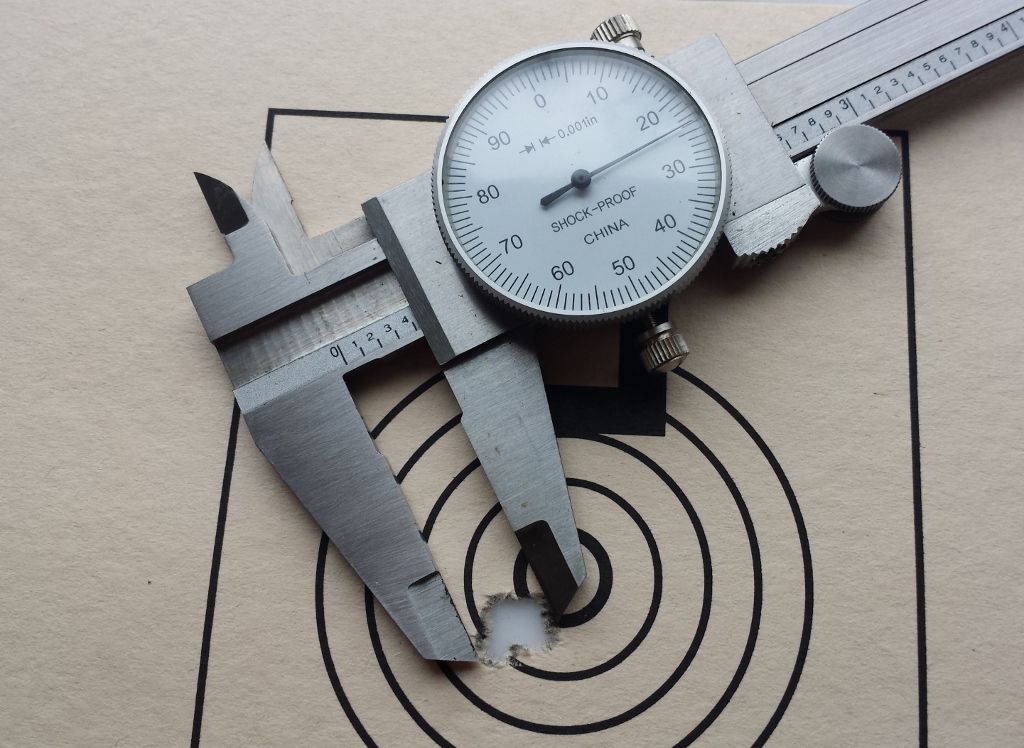 I measured the records from every angle and always get 0.424”. They’re 0.181” on the nose. My initial thoughts on LT-32: The powder is fairly insensitive to temperature, which isn’t a surprise. That’s how Accurate advertises the stuff. In mild humidity it performs with 26.9, 27.7 and 28.3 grs and the 68 gr Ultra. Those nodes hold for the 30 degrees I shot last week and the 90+ back in August. However really moist air causes it to jump tune. I don’t know the tipping point but I'd guess above 70%. I’ll need a few days of high humidity to prove this; and more importantly find what the gun wants in that environment. -Lee www.singleactions.com"Chasing perfection five shots at a time" |
|
ProGun
.30 Stingray

Posts: 246
|
Post by ProGun on Nov 30, 2015 21:04:25 GMT -5
Heavens to Betsy! Almost time to take that girl out in public and start winning some matches...
|
|
cmillard
.375 Atomic
   MOLON LABE
MOLON LABE
Posts: 1,989
|
Post by cmillard on Nov 30, 2015 22:20:43 GMT -5
very nice!!
|
|
|
|
Post by Lee Martin on Dec 1, 2015 20:03:43 GMT -5
Seating Depth Changes ____________________________ It pays to re-check seating depth relative to the barrel. That’s because as the round count climbs erosion occurs in the lead and throat. My process for determining where the ogive touches the lands is simple. Using a zippo lighter I smoke the bullet, size the neck for mild tension, and long seat. The length is first measured in an ogive gauge and noted. Initially that figure was 2.362”. Then the cartridge is chambered, removed, and re-measured (be sure to lube the locking lugs prior to closing the bolt). The new reading was 2.357” which means the bullet jammed 0.005”. Next I steel wool and blacken the tip again. When chambered the ogive should now just kiss the rifling. Inspection under a 6x loop shows very faint marks; typically 1/2" the width of the land front-to-back. I record that number and adjust my seater plug down by 0.005”. 2.362” is a #40 on my Sinclair so 2.357” is a #35. Five-thousandths jump would be #30, ten-thousandths would be #25, and so forth.  After 500 shots I seated the bullet to 2.368” and stuck it in the gun. Now my jam length is 2.361”, suggesting the lead washed away 0.004”. In order to touch, the seater is repositioned to #39. I do recommend using the same bullet for consistency sake. Even when hand-swaged ogives can vary a thousandth or two. Later on I’ll cover how those variations are measured. The tips after being chambered to touch. Notice two of the six land imprints are visible: 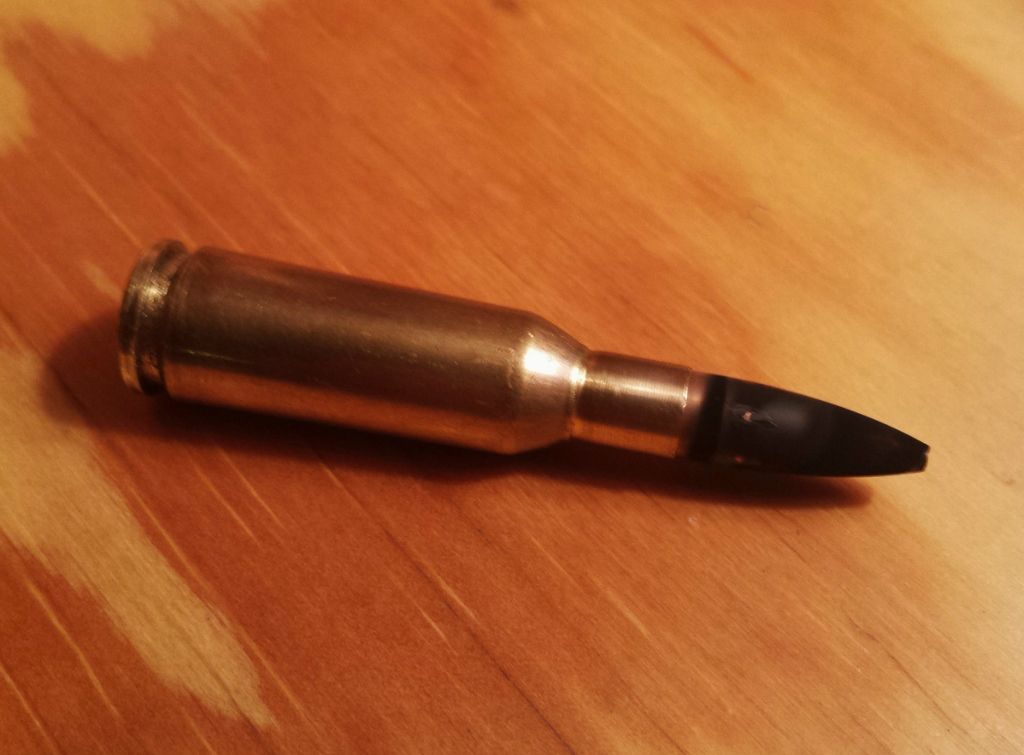 Measuring the base to ogive length: 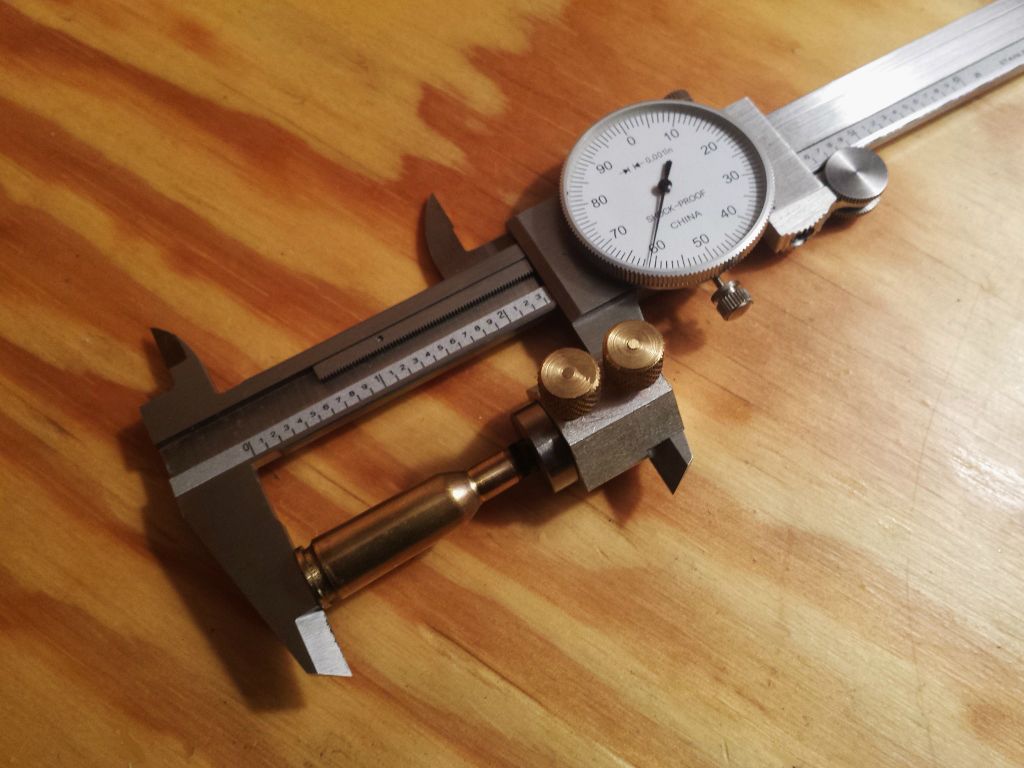 Seater stem on #39:  This Saturday I’ll try a few at #39 and see how they fly. Even with 0.004” in lead loss the gun has been deadly. If it performs similarly at #39 I’ll move to that setting. Otherwise I’ll continue shooting #35 until precision falls off. But you can’t chase the lead forever. Eventually the throat will erode and fire-crack enough to degrade performance. At that stage you have two options: 1) Set the barrel back an inch or two and re-chamber, or 2) Install a new blank. -Lee www.singleactions.com"Chasing perfection five shots at a time" |
|
|
|
Post by Lee Martin on Dec 7, 2015 19:53:42 GMT -5
Ed Shilen – RIP _________________________________ Got word today that Ed Shilen has passed away at age 84. I never had the pleasure of meeting him but we’ve shot his barrels since the early 1980’s. His contributions to benchrest are too numerous to recap since they span 60+ years. But as Precision Shooting magazine used to say, “we are diminished”. Ed Shilen bore-scoping a barrel: 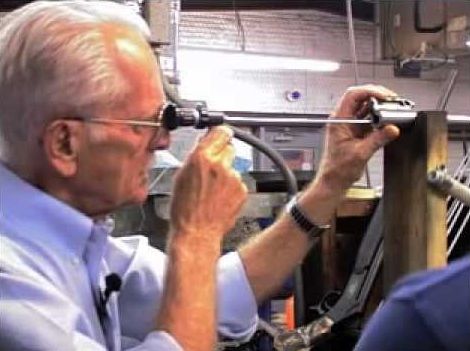 -Lee www.singleactions.com"Chasing perfection five shots at a time" |
|
|
|
Post by bradshaw on Dec 8, 2015 22:11:26 GMT -5
There is no telling how many Unlimited category silhouette tournaments have been won with Shilen barrels. While the accuracy requirement of pistol----or rifle----silhouette is crude by bench rest standards, the marksmanship required for serious play is stiff indeed. (Leastwise it used to be.) Ed Shilen was the opposite of a blowmouth and would never tell you his barrels were better than the work of other top makers. Nevertheless, firing line and winner's circle would tell you the barrels of Ed Shilen are fine indeed.
David Bradshaw
|
|
cmillard
.375 Atomic
   MOLON LABE
MOLON LABE
Posts: 1,989
|
Post by cmillard on Dec 9, 2015 8:32:07 GMT -5
funny you mention that bradshaw, there is a specific barrel maker that I will never buy another barrel blank from because they say they don't make a bad barrel. when I told them what was going on with the barrel in question (I had another of their barrels that wasn't a real great shooter) and there were several issues, they pointed all the blame at me. I have not shot a shilen yet and have only heard good things about them. the barrel maker I was talking about will stay nameless but they have been around a while. have had awesome luck with criterion, Krieger, benchmark, and douglas--I like to try a different barrel manuf every time
|
|
|
|
Post by BigBore44 on Dec 9, 2015 10:33:15 GMT -5
Sorry to hear of Mr. Shilen passing.. May he rest in peace and my condolences go out to his family and friends..
BigBore44 |
|
|
|
Post by squawberryman on Dec 10, 2015 5:28:46 GMT -5
Please for give my ignorance but where exactly within those squares and circles is the POA? Not your typical sight in target
|
|
ProGun
.30 Stingray

Posts: 246
|
Post by ProGun on Dec 10, 2015 10:27:50 GMT -5
I think in shooting benchrest, the POI is intended to not disrupt the sight picture on POA... It's just the group size that matters. Precision, not accuracy.
|
|
|
|
Post by Lee Martin on Dec 10, 2015 20:06:05 GMT -5
Ed Shilen Obituary _________________________________ We’ve chambered well over 40 barrels from Shilen. Some shoot better than others but I can emphatically say all perform at a very high level. On a side-note my family is originally from Pittsburgh and so was Ed. That had little to do with why we bought his blanks but it was a neat connection. Here’s his formal obituary from 12/09: Edward Michael Shilen, 84, current resident of Gun Barrel City, Texas, passed away on Monday, December 7, 2015. Ed was born January 27, 1931, to Michael John Shilen and Mary Wilma Frakowski, in Alleghany, Pennsylvania, a suburb of Pittsburgh. He grew up in Pittsburgh and graduated from Allderdice High School. He soon married Emily Brundage and started a family. They lived in both Virgil and Hyde Park, New York. In 1966, he moved his family to Irving, Texas, to build a new business based upon the love of his hobby of Competition Benchrest Shooting, and his pursuit of extreme accuracy in the Shooting Industry. The business grew and he moved Shilen Rifles, Inc. to Ennis, Texas in 1974. His love of competition and shooting lead him to set numerous World Records, leading to an induction into the Benchrest Hall of Fame. He was also an avid dog lover, golfer, pilot of both power planes and sailplanes, a remote control airplane enthusiast, race car driver, sailor, and scuba diver. He was an adventurer at heart, and always lived life to the fullest. He was a very patient and thorough teacher of any knowledge or skill he had. He was always willing to teach someone. He is survived by son Douglas Shilen and wife Patricia; daughter Mikel Shilen-Hull; granddaughter Jenifer (Shilen) Reese and husband Chris; grandson Jeff Holubar and wife April; granddaughter Katie Holubar; Bob Skrivanek, father of great grandchildren Tyler Skrivanek and Whitney Skrivanek; great grandsons Jacob Reese and Eli Reese, and sister Dolores Joyce. He is preceded in death by his parents, wife Emily (Brundage) Shilen, wife Charlene (Wright) Shilen, and granddaughter Julie (Shilen) Skrivanek. In lieu of flowers, the family requests donations be made to the American Lung Association -Lee www.singleactions.com"Chasing perfection five shots at a time" |
|
|
|
Post by Lee Martin on Dec 10, 2015 20:11:38 GMT -5
Please for give my ignorance but where exactly within those squares and circles is the POA? Not your typical sight in target Aiming Points ________________________ Benchrest targets are a little confusing. Many wonder about the black square and assume it’s an aiming point. It isn’t. However it does serve a few useful purposes. For instance, when mirage is bad that’s often all you can see. Judging your point-of-aim relative to the movement of the square is one trick. Others use it to line-up their crosshairs (see below). It can also assist with holding off since the dimensions are known. In group BR it really doesn’t matter where you aim as long as all five land in the record half. Common POA techniques are depicted here: Center mothball:  6 o’clock or 12 o’clock on the mothball:  Crosshair alignment on each axis. Here the horizontal is on the bottom of the mothball while the vertical cuts the inner edge of the square:  I hold at 6 o’clock on the mothball with the POI just to the left. The x-crosshair touches the circle and the y splits it and the square. Some prefer the holes to land far from the POA. I like having them close by. For me it makes holding off quicker when adjusting by caliber. The last aiming illustration is very precise since each crosshair is on defined border. This method takes longer though and can slow you down when running shots. -Lee www.singleactions.com"Chasing perfection five shots at a time" |
|
|
|
Post by Lee Martin on Dec 10, 2015 20:15:13 GMT -5
Cutting Groups – Part VII ____________________________________ Iosso treatment of the throat and seating depth changes didn’t hurt performance. If anything they improved the gun’s consistency. Results from last Saturday: My second group was almost another screamer. Shooting the higher node of 28.3 grs it went 0.105” • Time – 9:35 AM • Temp = 44.3, humidity = 58.9% • 28.3 grs of LT-32, Lot #6 (51.5 Culver measure) • Velocity – TBD • 68 grain FB Bart’s Ultra • Seating – touch / slightly in (#39 Sinclair seater) • Brass – Lapua, 11th firing • 0.0015” neck tension – 0.261” bushing • CCI BR-4 primer • Shoulder bump = 0.001” • Loaded neck = 0.2625” on a 0.264” chamber. 0.0015” clearance Spread = 0.348” – 0.243” = 0.105”  The third group measured 0.135”: • Time – 10:01 AM • Temp = 45.1, humidity = 56.7% • 28.3 grs of LT-32, Lot #6 (51.5 Culver measure) • Velocity – TBD • 68 grain FB Bart’s Ultra • Seating – touch / slightly in (#39 Sinclair seater) • Brass – Lapua, 11th firing • 0.0015” neck tension – 0.261” bushing • CCI BR-4 primer • Shoulder bump = 0.001” • Loaded neck = 0.2625” on a 0.264” chamber. 0.0015” clearance Spread = 0.378” – 0.243” = 0.135” 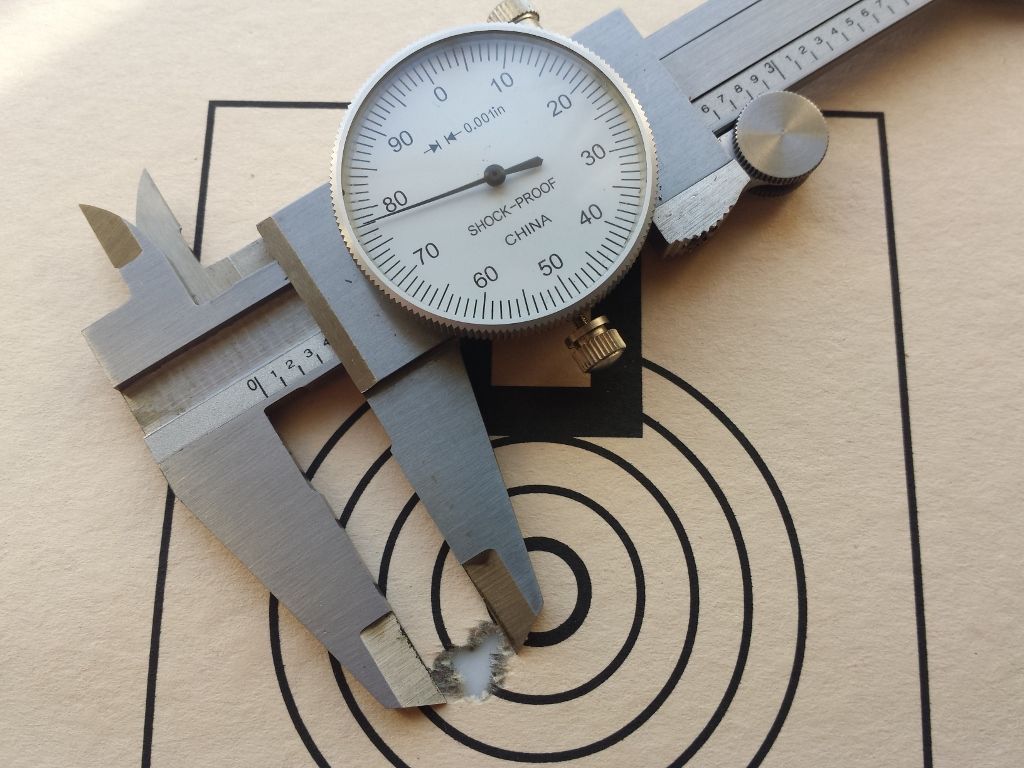 My fourth group walked out due to a break in concentration. I stretched cleaning to three targets, prepped the bore, and tacked up the next piece of paper. Notice anything wrong with this one? I’ll give you a hint...the sighter is bare. Once again I accidentally went straight to the record half. Shot number one is high, then the next four did 0.118". Center-to-center this is a disappointing 0.414”.  Eight groups were fired and averaged 0.193”. Damn good consistency but I must admit the winds were light. I have two more 13.5 twist Shilen blanks on the shelf. Let’s hope they shoot equally well. -Lee www.singleactions.com"Chasing perfection five shots at a time" |
|
|
|
Post by squawberryman on Dec 11, 2015 5:56:53 GMT -5
The thought of POI being different than POA is awesome to think about. Thank you for the explanation.
|
|